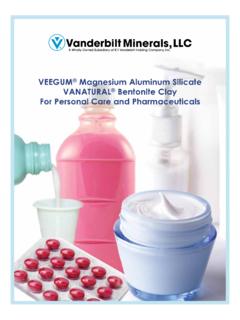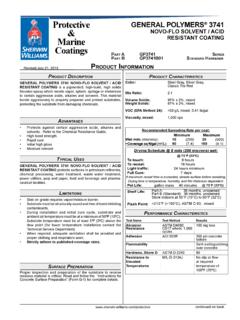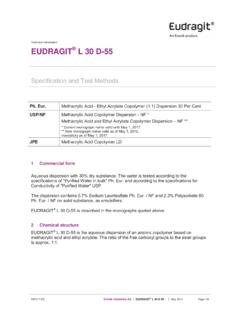Transcription of Mixing and compatibility guide for commonly used ...
1 Note Aerosolized medications note Mixing and compatibility guide for commonly used aerosolized medications David K. Burchett, William Darko, James Zahra, John Noviasky, Luke Probst, and Adrienne Smith C. ompatibility references of medications provide easily ac- Purpose. A Mixing and compatibility guide and respiratory therapists who administer cessible information to guide for commonly used aerosolized medica- aerosolized medications. The authors of a tions was developed. recently published evaluation of the com- the safe administration of parenteral Summary. compatibility guides for inject- patibility of common inhalation solutions ,2 On the other hand, com- able drugs are available as a reference for summarized their findings in a concise patibility information for inhaled pharmacists, nurses, and medical person- table. This table served as a template to aerosolized medications is ,4 nel. These charts are commonly used in develop a more comprehensive Mixing A compatibility chart can po- hospitals and other health care institutions and compatibility guide in the form of an tentially save time by answering and provide a quick, easy reference for easy-to-use reference chart, which includes the most common questions about compatibility of frequently used intrave- additional agents, compatibility references nous medications.
2 Respiratory therapists on the chart, and compatibility information admixtures. A chart can provide a are frequently directed to administer for pharmacists, nurses, physicians, and quick and easy reference for medical various aerosolized medications and are respiratory therapists. personnel about compatibility of fre- often faced with the challenge of uncertain Conclusion. A compatibility guide for quently used medications, includ- compatibility of these drugs when mixed aerosolized medications was developed ing chemotherapy agents, antibiotics, together. However, there appear to be for use by staff who administer these vasopressors, and other drugs. limited data regarding the compatibility of agents. Locating this information can be these aerosolized admixtures. After a care- ful review of the literature, a compatibility Index terms: Aerosols; Compounding;. very challenging, as it often can be chart was developed that should provide Guidelines; Incompatibilities; Stability found only in the primary literature.
3 Significant value to pharmacists, nurses, Am J Health-Syst Pharm. 2010; 67:227-30. Trials are heterogeneous, and results can be confusing, even contradic- A careful review of which inha- lation admixtures were tested and the cal Pharmaceutics Database6 provide relatively unfamiliar to nurses, re- methods used for testing is critical comprehensive data on several aero- spiratory therapists, and physicians. when reading these published trials. solized drugs, including compat- There is no aerosolized admixture Trissel's Stability of Compounded ibility and stability data for various counterpart to the parenteral ad- Formulations5 and Trissel's 2 Clini- admixtures. These references are mixture chart. David K. Burchett, , was Candidate, Albany Department of Pharmaceutical Care Services; and Adrienne Smith, College of Pharmacy, Albany, NY, at the time of writing. William , BCOP, was Assistant Professor of Medicine, Department Darko, , is Assistant Professor of Medicine, Department of of Medicine, Section of Clinical Pharmacology, and Department of Medicine, Section of Clinical Pharmacology, and Adjunct Associate Pharmaceutical Care Services, SUNY Upstate Medical University Professor of Pharmacy Practice, Department of Pharmaceutical Care Hospital, Syracuse, at the time of writing.
4 Services; James Zahra, , is Adjunct Assistant Professor of Address correspondence to Dr. Darko at SUNY Upstate Medi- Pharmacy Practice, Senior Pharmacist, and Intravenous Laboratory cal University Hospital, 750 East Adams Street, Syracuse, NY 13210. Coordinator, Department of Pharmaceutical Care Services; John Noviasky, , is Assistant Professor of Medicine, Depart- The authors have declared no potential conflicts of interest. ment of Medicine, Section of Clinical Pharmacology, and Associate Director, Clinical Services and Research, Department of Pharma- Copyright 2010, American Society of Health-System Pharma- ceutical Care Services; Luke Probst, , BCPS, is Assistant cists, Inc. All rights reserved. 1079-2082/10/0201-0227$ Professor of Medicine, Department of Medicine, Section of Clinical DOI Pharmacology, and Associate Director, Pediatric Clinical Services, Am J Health-Syst Pharm Vol 67 Feb 1, 2010 227. Figure 1. compatibility guide for commonly used inhalation solutions and suspensions.
5 Dark green shading with corresponding letter C indicates that there is evidence in the form of clinical studies confirming the stability and compatibility of the particular admixture. Light green shading with corresponding letter C indicates that there is evidence from manufacturers'. 228. reports confirming the stability and compatibility of a particular admixture3; in many instances, these studies were unavailable for review and were confirmed either by reference in the package insert or direct communication with the manufacturer. Red shading with corresponding letter X indicates that there is evidence confirming or suggesting that a particular admix- note Aerosolized medications ture is not compatible. Yellow shading with corresponding letters NI indicates that there is insufficient evidence to evaluate compatibility and should be avoided unless future evidence becomes available. Blue shading with corresponding letters CD indicates that there are conflicting data regarding compatibility of the combination.
6 The following information should be considered when determining the feasibility of preparing drug combinations for inhalation: (1) all admixtures should be prepared from formulations that do not contain preservatives, (2). Am J Health-Syst Pharm Vol 67 Feb 1, 2010. The United States Pharmacopeia requirements state that the particle size of the delivered drug must be carefully controlled and the average diameter must be <5 mm, (3) physical and chemi- cal compatibilities do not describe possible effects on aerodynamic behavior, (4) decreases in temperature can occur in certain nebulizers, and the effect of such decreases on compatibility has not been studied, (5) Mixing solutions or suspensions increases total volume, and the relationship between the volume fill, total mass output, and inhaled mass of nebulized drug must be considered, and (6) if admixtures are to be stored, sterility issues must be addressed. References should be consulted to verify drug concentrations are compatible.
7 Sodium Chloride Dornase Albuterol Arformoterola Epinephrineb Formoterol Levalbuterolc Metaproterenold Budesonide Cromolyne Ipratropium Acetylcysteinef Colistimethateg Tobramycinh Solutions Alfa Albuterol NI NI NI NI NI C3 C3,i C3,i,j NI C3,k C3 NI X3. Arformoterol NI NI NI NI NI Ca NI Ca Ca NI NI NI X3. Epinephrine NI NI NI NI NI NI C11 NI NI NI NI NI X3. Formoterol NI NI NI NI NI C 13. NI NI NI NI NI NI X3. Levalbuterol NI NI NI NI NI C3,c Cc Cc NI NI NI NI X3. Metaproterenol NI NI NI NI NI NI C11 C3 NI NI NI NI X3. Budesonide C3 Ca NI C13 Cc NI C3,l C3 C3 NI X3 NI X3. Cromolyn C 3,i NI C 11. NI Cc C 11. C 3,l C 3,m C3,11. NI X 3. NI X3. Ipratropium C3,i,j Ca NI NI Cc C3 C3 C3,m C14 NI C3 NI X3. Acetylcysteine NI Ca NI NI NI NI C3 C3,11 C14 C3,n NI NI X3. Colistimethate C3,k NI NI NI NI NI NI NI NI C3,n CD3 NI X3. Tobramycin C 3. NI NI NI NI NI X 3. X 3. C 3. NI CD 3. NI X3. Sodium NI NI NI NI NI NI NI NI NI NI NI NI X3. Chloride Solutions Dornase Alfa X3 X3 X3 X3 X3 X3 X3 X3 X3 X3 X3 X3 X3.
8 A No safety and efficacy studies available for admixtures of arformoterol with other drugs; physical and chemical compatibility studies with acetylcysteine, ipratropium, budesonide, and tiotropium have indicated compatibility of concentrations studied (Quon CL, Sepracor, personal communication, 2009 Sep 24). b Epinephrine is readily destroyed by oxidizing agents or alkali ( , sodium bicarbonate, halogens, permanganates, chromates, nitrates, nitrites) and salts of easily reducible metals ( , iron, copper, zinc).7. c No safety and efficacy studies available for admixtures of levalbuterol with other drugs; physical and chemical compatibility studies with budesonide, cromolyn, and ipratropium have indicated compatibility of concentrations studied (Quon CL, Sepracor, personal communication, 2009 Sep 24). d No safety and efficacy studies available for admixtures of metaproterenol with other drugs available from manufacturer (Lee S, Dey Laboratories, personal communication, 2009 Sep 24).
9 E compatibility of cromolyn (Intal, King Pharmaceuticals) with albuterol (Ventolin, GlaxoSmithKline), fenoterol (Berotec, Boehringer Ingelheim), metaproterenol (Alupent, Dey Laboratories), and terbutaline (Bricanyl, AstraZeneca) confirmed by f Acetylcysteine (Mucomyst, Sandoz Pharmaceuticals) has been reported to be compatible with netilmicin or The manufacturer reports that acetylcysteine is incompatible with amphotericin B, tetracyclines, erythromycin, or ampicillin; also incompatible with any oxidizing agent, iodized oil, trypsin, chymotrypsin, and hydrogen g Colistimethate sodium (available as an injectable formulation in the United States; dosage expressed in terms of colistin) is not approved for inhalation via a nebulizer; a case of acute respiratory failure and subsequent death of a cystic fibrosis patient who received premixed colistimethate sodium via nebulization has been The prescribing information for a formulation available outside of the United States (Colistin, Grunenthal).
10 States that precipitation may occur in admixtures with other nebulized h Tobramycin solution for oral inhalation should not be diluted or mixed with other drugs in the nebulizer. Based on protocols used in clinical studies evaluating tobramycin solution for oral inhalation in cystic fibrosis patients, it has been recommended that patients receive doses of inhaled bronchodilators first, then dornase alfa, then chest physiotherapy, and then i Admixtures of albuterol, cromolyn, and ipratropium appear to be stable, with ipratropium as the limiting j Albuterol and ipratropium are available as a combination solution for nebulization (Duoneb, Dey Laboratories, Napa, CA). k Albuterol containing benzalkonium chloride (1 mL) mixed with 1 mL colistin (Coly-Mycin M Parenteral, mg/mL, King Pharmaceuticals) resulted in immediate cloudiness, which was believed to be due to interaction of benzalkonium chloride with colistin (effect on aerodynamics unknown); colistin mixed with preservative-free unit-dose albuterol inhalation solution was chemically stable for one No additional information available from manufacturer (Guinto A, JHP Pharmaceuticals, personal communication, 2009 Sep 24).



